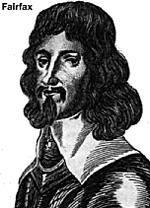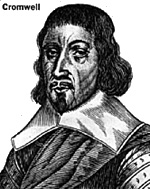THE ARMIES
THE PARLIAMENTARIANS FORCES
 Manchester's army was made up from contingents of the Eastern Association forces
and Sir Thomas Fairfax's Yorkshire cavalry. It was reported to consist of 37 troops of horse
and dragoons, of which: 25 were evidently Fairfax's men.
Manchester's army was made up from contingents of the Eastern Association forces
and Sir Thomas Fairfax's Yorkshire cavalry. It was reported to consist of 37 troops of horse
and dragoons, of which: 25 were evidently Fairfax's men.
EASTERN ASSOCIATION
 Under the overall command of the Earl of Manchester, with Oliver Cromwell as Lieutenant-General of Horse and Sir Miles Hobart commanding the foot. Both Manchester's and Cromwell's Regiments were theoretically well over normal establishment, so, assuming the figures regarding Fairfax's horse are correct, there can only have beeh detachments present.
Under the overall command of the Earl of Manchester, with Oliver Cromwell as Lieutenant-General of Horse and Sir Miles Hobart commanding the foot. Both Manchester's and Cromwell's Regiments were theoretically well over normal establishment, so, assuming the figures regarding Fairfax's horse are correct, there can only have beeh detachments present.
- Earl of Manchester's Regiment of Horse (3 troops? 150 men?)
- Oliver Cromwell's Regiment of Horse (6 or 7 troops? c. 350 men?)
- Quartermaster-General Cornelius Vermuyden (2 Troops of Dragoons? 200 men maximum)
Although Manchester was reported to have had at least 5,000 foot with him at Boston, there is no evidence to suggest that all of these were available at Winceby. Present at the siege of Bolingbroke were 10 companies of foot under Sir Miles Hobart, but these would not come up in time to take part in the action.
THE YORKSHIRE FORCES
Sir Thomas Fairfax was probably the most experienced Parliamentarian commander at Winceby. He had had his fair share of mixed fortunes since 1642 and had proved a highiy capable leader of horse. The make-up of his forces is to some extent problematic, but elements of the following regiments were probably present in his force of about 1,200 horse.
- Sir Thomas Fairfax's Regiment of Horse
- Sir William Fairfax's Regiment of Horse
- John Lambert's Regiment of Horse
- Christopher Copley's Regiment of Horse
- Hugh Bethell's Regiment of Horse
Troops must have averaged about 50 men, and regiments 2-300 troopers.
THE ROYALIST FORCES
Command structure uncertain. It seems most likely that Sir John Henderson was in command, possibly because the Newark forces made up the largest contingent of the Royalist army. He was a Scottish professional soldier who had served in the Thirty Years War, and was appointed Governor of Newark in December 1642. Also present was Sir William Widdrington, Royalist commander in Lincolnshire, Nottinghamshire and Rutland, who might have been expected to have been general. The other senior commander was Sir William Saville, an important Yorkshire Royalist, who fought in most of the major Northern actions.
THE HORSE
According to Parliamentarian accounts, 74 cornets of Royalist horse were counted, which, if the same number of full-strength troops had been present, would have totalled something like 4,000 men. As no more than half this number were available, it follows that most of the Royalist units must have been badly understrength. Regiments which may have been represented, in some cases probably by detachments, were
- Sir Peregrine Bertie's Regiment of Horse (Newark)
- Lord Henry Cavendish's Regiment of Horse (Yorkshire )
- Henry Cromwells Regiment of Horse (Lincolnshie)
- Sir Charles Dallison's Regiment of Horse (Lincolnshire)
- Sir Robert Dallison's Regiment of Horse (Newark)
- Ralph Eure's Regiment of Horse (Newark)
- Lord Ethin's Regiment of Horse (Yorskshire)
- Sir John Henderson's Regiment of Horse (Newark)
- Sir Ingram Hopton's Regiment of Horse (Lincolnshire)
- Sir William Pelham's Regiment of Horse (Newark)
- Sir William Saville's Regiment of Horse (Yorkshire)
- Anthony Eyre's Regiment of Horse (Newark)
- Samuel Tuke's Regiment of Horse (Duke of York's, ex-Charles Cavendish) (Yorkshire)
- Lord Widdrington's Regiment of Horse (Yorkshire)
- Robert Brandling's Regiment of Horse (Northumberland)
DRAGOONS
About 750 men, probably including Sir William Saville's, Samuek Tuke's and Lord Widdrington's Dragoons but is unclear how far the Northern Royalist forces by this time maintained separate regiments of dragoons. very often they would consist of one or more troops attached to regiments of horse.
The Campaign to Winceby
The Battle of Winceby and Map
Back to Battlefields Vol. 1 Issue 4 Table of Contents
© Copyright 1996 by Partizan Press.
This article appears in MagWeb (Magazine Web) on the Internet World Wide Web.
Other military history articles and gaming articles are available at http://www.magweb.com